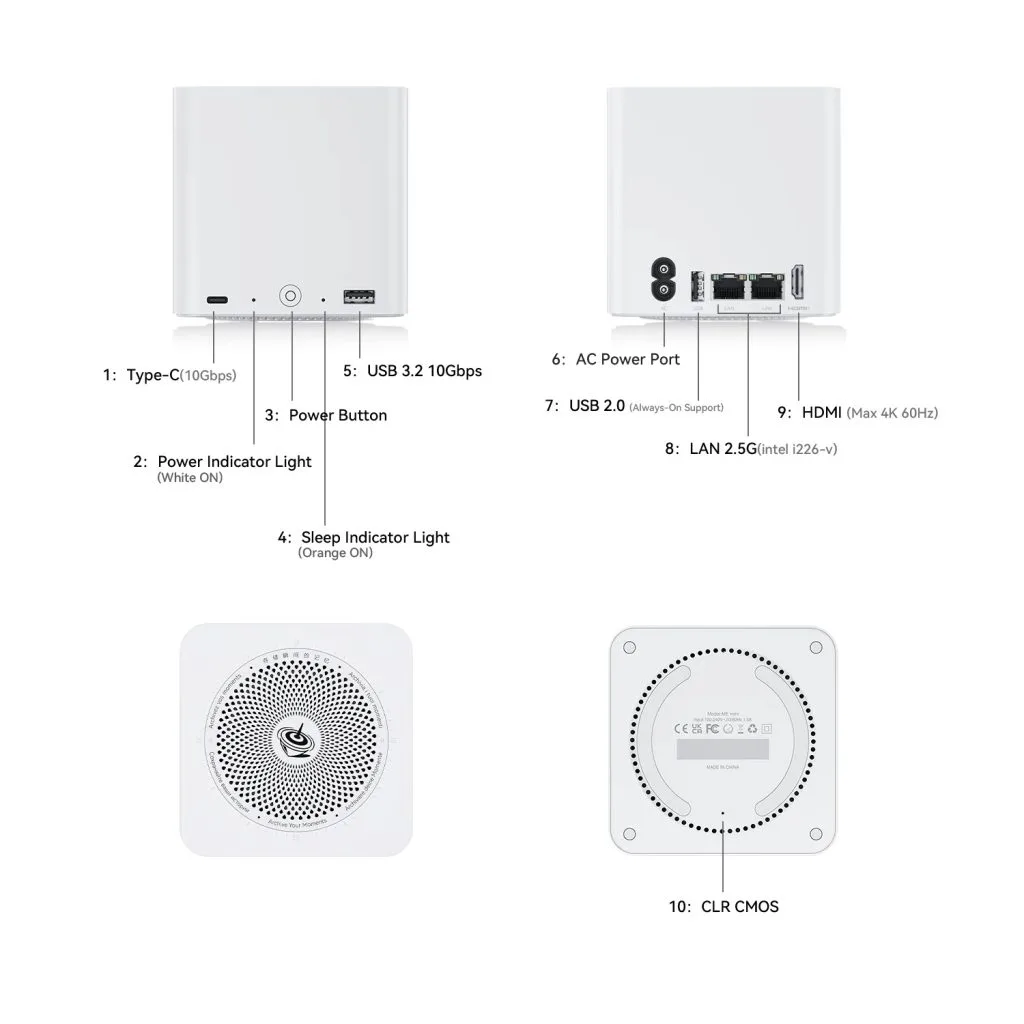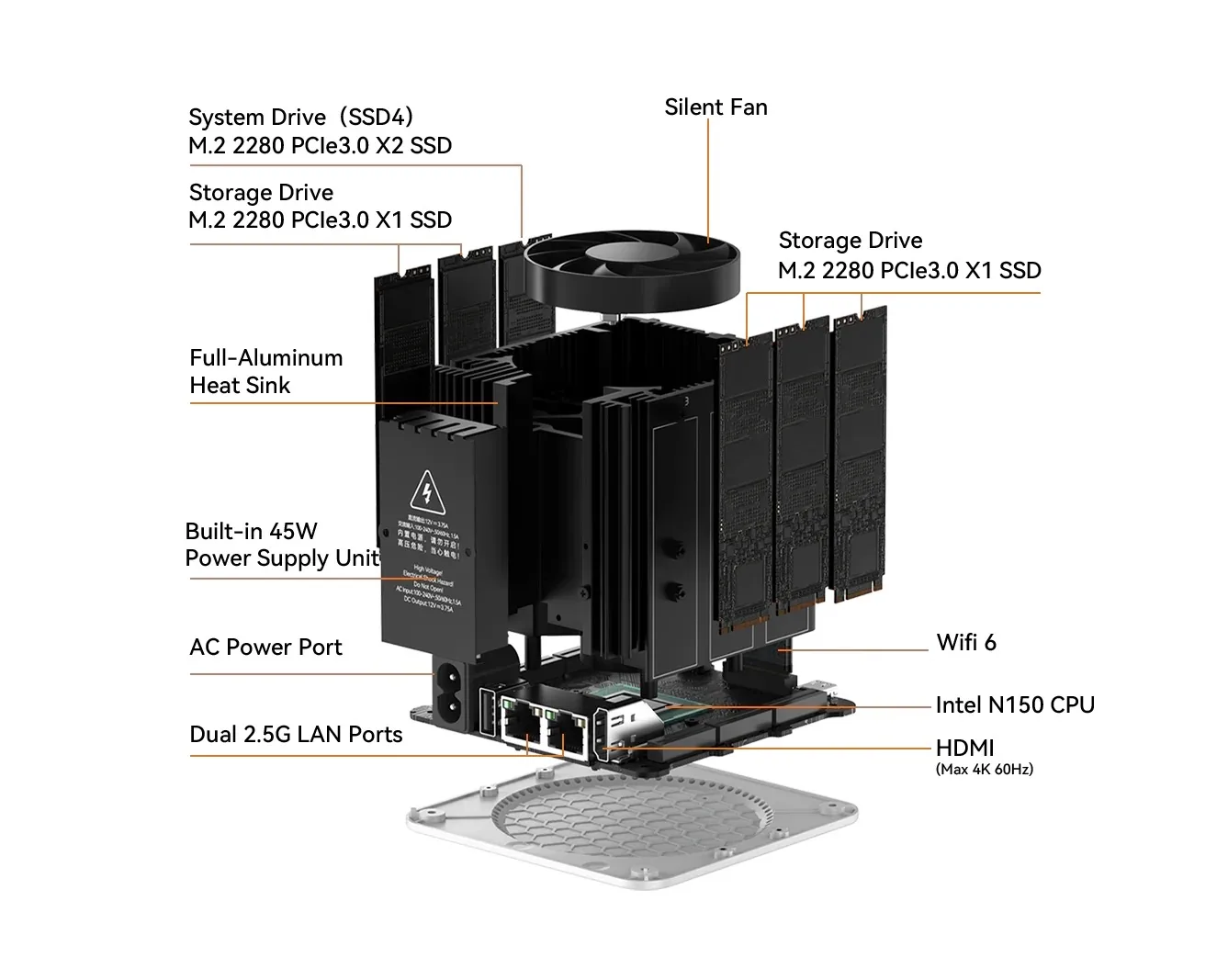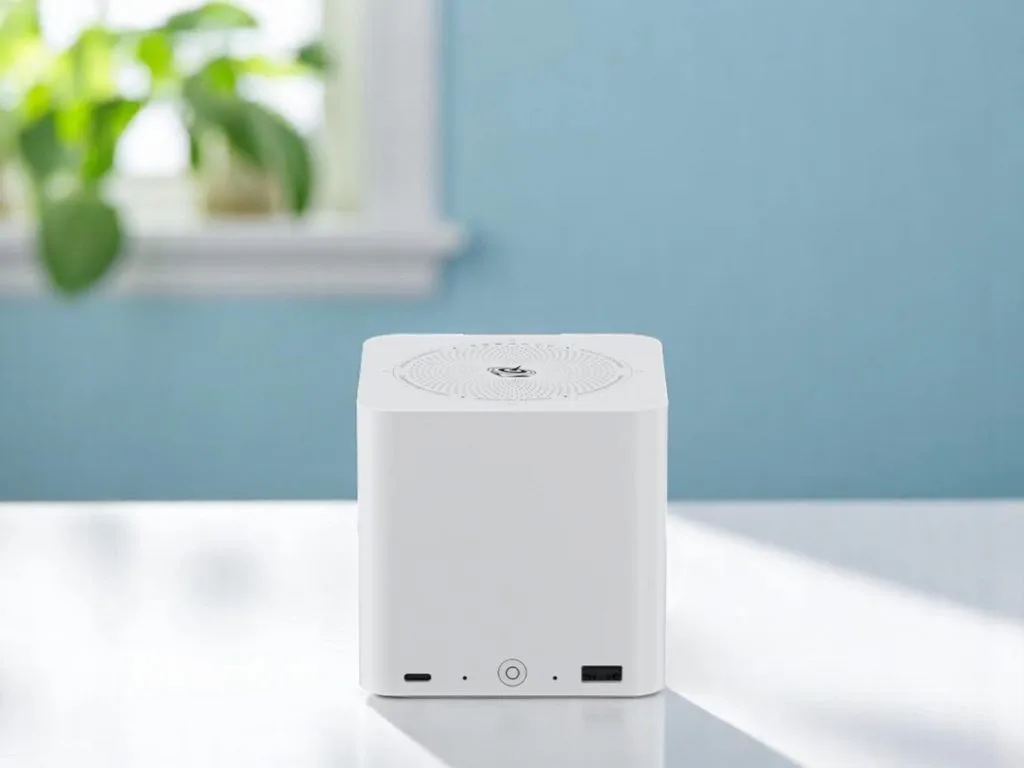After spending time with the newly released Beelink ME mini N150, I’m convinced this compact NAS represents a fascinating shift in home storage solutions.
This palm-sized device packs six M.2 NVMe slots into a form factor smaller than most traditional routers, promising up to 24TB of solid-state storage in whisper-quiet operation.
Beelink ME mini N150 Specifications and Overview
Compact NAS Design and Build Quality
The Beelink ME mini immediately impresses with its minimalist aesthetic and compact form factor.
What I like about this product is how Beelink managed to create something that doesn’t scream “tech device” – it blends seamlessly into any home environment.
The all-plastic construction feels solid despite its lightweight 730g (1.6 lbs) build, and the unique clock-pattern ventilation on top adds a subtle design flourish.

Port Layout and Dual 2.5GbE Mini PC Connectivity
Front-facing ports include USB 3.2 Gen 2 Type-A and Type-C (both 10Gbps), power button, and status LEDs.
The rear houses dual 2.5GbE ports, HDMI output supporting 4K@60Hz, and a USB 2.0 port for legacy devices.
In my experience, this port selection covers most home NAS requirements without unnecessary clutter.
Intel N150 NAS Performance and Processing Power
The Intel Twin Lake N150 represents a modest upgrade over the popular N100, maintaining the same 6-watt TDP while offering slightly higher burst frequencies.
Testing reveals the N150 achieves a Geekbench 6 single-core score of 1229 and multi-core score of 2540.
These numbers position it perfectly for core NAS functionalities without the power consumption penalties of higher-performance processors.
Intel N150 Processor Performance in Real-World Usage
Performance measurements indicate this Mini PC for home server applications excels at file sharing, backup operations, and light media streaming.
The integrated Intel UHD Graphics with 24 execution units provides excellent hardware transcoding capabilities for Plex server deployments.
6-Slot Home Storage NAS Architecture and M.2 Configuration
The heart of this compact NAS lies in its six M.2 NVMe slots, each supporting drives up to 4TB capacity.
However, the Intel N150’s PCIe limitation becomes apparent when examining the storage subsystem architecture.
PCIe Gen 3 NVMe Speeds and Lane Distribution
With only 9 PCIe Gen 3 lanes available from the N150 processor, compromises were inevitable.
Five storage slots operate at PCIe 3.0 x1 speeds, limiting throughput to approximately 985 MB/s per drive.
The system drive slot (Slot 4) receives preferential treatment with PCIe 3.0 x2 allocation, providing better performance for OS operations.
Crucial P3 Plus NVMe SSD Integration and Up to 24TB NAS Potential
Beelink’s partnership with Crucial ensures quality NVMe storage out of the box.
The included Crucial P3 Plus 2TB NVMe SSD provides reliable performance for most home applications.
With all six slots populated with 4TB drives, the ME mini achieves a theoretical 24TB capacity – enough for approximately 11,000 movies or 2.23 million songs.
Beelink ME mini Benchmarks and NVMe NAS Storage Performance
Sequential read testing demonstrates the PCIe limitations clearly, with benchmark results showing sustained reads of approximately 850-891 MB/s.
Random write performance reveals more impressive numbers, with IOPS reaching 402,000 and write speeds of 1,570 MiB/s.
These random I/O capabilities showcase where NVMe storage truly shines compared to traditional mechanical drives.
Network Throughput and Real-World NAS Performance
The dual 2.5GbE configuration supports link aggregation for theoretical 5Gbps (625 MB/s) throughput.
In practice, even with PCIe constraints, the storage subsystem rarely becomes the limiting factor for network-attached operations.
File transfer speeds consistently reached network limits during testing, demonstrating adequate performance for home and small office deployments.
Low Power NAS Server Consumption and Quiet Operation
One area where this low power NAS server truly excels is energy efficiency.
With three drives installed, the entire system draws just 7.9-9 watts – remarkable for a six-bay storage solution.
The vertical airflow cooling design maintains whisper-quiet operation while managing thermal loads from multiple NVMe drives.
Beelink ME mini TrueNAS Setup and Operating System Support
Installing TrueNAS Scale on the ME mini proved straightforward, though I encountered some initial quirks with the eMMC installation.
I recommend using one of the M.2 slots for the operating system rather than relying on the 64GB eMMC for optimal performance.
The default username is “TrueNAS admin” rather than the standard “admin” – a detail that initially caused confusion during setup.
TrueNAS Compatible and Alternative OS Options
This Intel N150 NAS performance extends beyond TrueNAS to support multiple operating systems including Windows 11 Pro, various Linux distributions, and Proxmox.
The x86 architecture ensures broad compatibility with NAS-specific distributions like OpenMediaVault and Unraid.
For users preferring Windows-based solutions, Beelink includes basic file-sharing configuration, though dedicated NAS operating systems offer superior features.
Best Mini NAS 2025 Comparison with Competitors
When evaluating this all-flash NAS system against alternatives like the Asustor Flashstor 6 or QNAP TBS-464, several factors emerge.
The Asustor solution costs approximately $449 diskless, while the QNAP option reaches $599 without drives.
What sets the ME mini apart is its aggressive pricing with included storage, making it an accessible entry point into high-density NVMe storage.
Beelink ME mini Pros and Cons Analysis
Small Form Factor NAS Advantages
- The compact home cloud storage design eliminates noise concerns entirely – no spinning drives means truly silent operation.
- Built-in PSU design reduces cable clutter and improves aesthetics significantly.
- Dual 2.5GbE connectivity future-proofs the device for faster network adoption.
- Energy efficient home server characteristics make it suitable for always-on deployment.
High Capacity M.2 NAS Limitations
- PCIe 3.0 x1 limitations significantly underutilize modern NVMe drive capabilities for most storage slots.
- Non-upgradable 12GB RAM may constrain advanced ZFS configurations or virtualization workloads.
- High-capacity M.2 SSD costs make fully populating the device expensive compared to traditional HDD solutions.
Who Should Buy This ME mini 6-bay NAS?
- This device excels for users prioritizing silence, compactness, and solid-state reliability over raw throughput.
- I’d recommend this for home users building family media servers, photo archives, or document storage systems.
- Small office deployments requiring quiet operation and minimal footprint will find this solution compelling.
Not Ideal for Heavy Virtualization or Enterprise Use
- Heavy virtualization workloads requiring substantial RAM and CPU resources should look elsewhere.
- Users planning intensive 4K transcoding for multiple simultaneous streams need more powerful processing.
- Cost-conscious buyers seeking maximum storage capacity per dollar will find traditional HDD solutions more economical.
Frequently Asked Questions
Is Beelink ME mini good for a home NAS?
Yes, the Beelink ME mini excels as a home NAS for users prioritizing quiet operation and compact design.
Its 8-watt power consumption and solid-state storage make it ideal for 24/7 operation in noise-sensitive environments.
How much storage can the Beelink ME mini N150 support?
The ME mini supports up to 24TB total storage using six 4TB M.2 NVMe SSDs in its six available slots.
Each slot accommodates M.2 2230, 2242, and 2280 form factors with maximum 4TB capacity per drive.
What operating systems can Beelink ME mini run?
The Intel N150 x86 architecture supports Windows 11 Pro, TrueNAS Scale, OpenMediaVault, Unraid, various Linux distributions, and Proxmox.
The included 64GB eMMC storage can host lightweight NAS operating systems while preserving M.2 slots for data storage.
Is the Intel N150 powerful enough for NAS tasks?
Yes, the Intel N150’s 4-core design and integrated graphics handle typical NAS operations including file serving, backup services, and media streaming effectively.
The processor’s AV1 hardware decoding supports modern media formats for efficient Plex server operation.
What are the M.2 slot speeds on the Beelink ME mini?
Five storage slots operate at PCIe 3.0 x1 speeds (approximately 985 MB/s), while the system slot (Slot 4) receives PCIe 3.0 x2 allocation for better performance.
This limitation stems from the Intel N150’s 9 PCIe lane constraint requiring careful bandwidth allocation across all slots.
Does the Beelink ME mini come with WiFi?
Yes, the ME mini includes WiFi 6 (Intel AX101) and Bluetooth 5.2 connectivity alongside dual 2.5GbE wired ports.
The wireless capabilities provide flexible connectivity options for initial setup and mobile device access.
What is the price of the Beelink ME mini N150?
The ME mini N150 is priced at $329 including 12GB LPDDR5 RAM, 64GB eMMC storage, and a 2TB Crucial NVMe SSD.
This represents competitive pricing compared to diskless alternatives from established NAS manufacturers.
What is the Beelink ME mini power consumption?
Testing shows power consumption of approximately 8 watts with three drives installed, making it extremely energy efficient for continuous operation.
The 6-watt TDP processor and SSD-only storage contribute to minimal electricity costs.
Can the Beelink ME mini run a Plex server effectively?
Yes, the Intel N150‘s integrated graphics provide excellent hardware transcoding capabilities for Plex media server applications.
The processor handles multiple 1080p streams and select 4K content efficiently with hardware acceleration enabled.
How do I install TrueNAS on the Beelink ME mini?
Create a TrueNAS installation USB drive, boot from it, and select either the 64GB eMMC or a dedicated M.2 SSD for installation.
Use “TrueNAS admin” as the username during login, not the standard “admin” that some tutorials reference.

How does Beelink ME mini compare to Synology NAS?
The ME mini offers superior compactness and silence through all-SSD design, while Synology provides mature software ecosystems and larger capacities via 3.5″ drives.
Choose the ME mini for quiet environments and fast access times, Synology for comprehensive software features and cost-effective high capacity.
What are the pros and cons of the Beelink ME mini?
Pros include ultra-quiet operation, compact design, dual 2.5GbE networking, and competitive pricing with included storage.
Cons encompass PCIe bandwidth limitations, non-upgradable RAM, high costs for maximum capacity, and lack of barebones options.
Is the Beelink ME mini worth buying?
For users prioritizing silence, compactness, and solid-state reliability over maximum throughput, the ME mini represents excellent value at $329.
Consider your specific needs regarding storage capacity costs and performance requirements before purchasing.
Does the Beelink ME mini have thermal issues?
The ME mini’s vertical airflow design and advanced convection cooling appear effective for thermal management.
Unlike some competitors with reported overheating problems, the ME mini maintains stable operation during testing periods.
Where can I buy the Beelink ME mini N150?
The ME mini N150 is available through Beelink’s official website and authorized retailers with worldwide shipping options.
The company offers a 30-day risk-free trial period and one-year warranty coverage for peace of mind.
Final Thoughts
The Beelink ME mini represents an intriguing evolution in compact NAS design, successfully cramming six M.2 slots into a remarkably small package.
While PCIe limitations prevent individual drives from reaching full potential, the aggregate performance still exceeds network bottlenecks in most scenarios.
I found this device particularly compelling for users who value silence and aesthetics alongside functional storage capabilities.
For $329 with included 2TB storage, it offers competitive entry into high-density NVMe storage, though fully populating all slots requires significant additional investment.




Can I host my website on this? How about a couple of family sites or blogs? Could I start with the single 2T SSD and add a couple of 4T drives, or do the SSDs all have to be the same size? I like the Beelink because of its size and capacity, but I’m wary of the fixed memory in such a small amount.
Pay no attention to my website address because it’s just a placeholder at the moment. But I’d also like to host that email address.
Thanks in advance,
jayne, the sergeant majorette